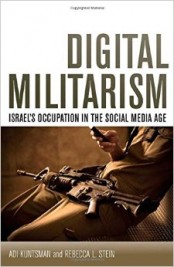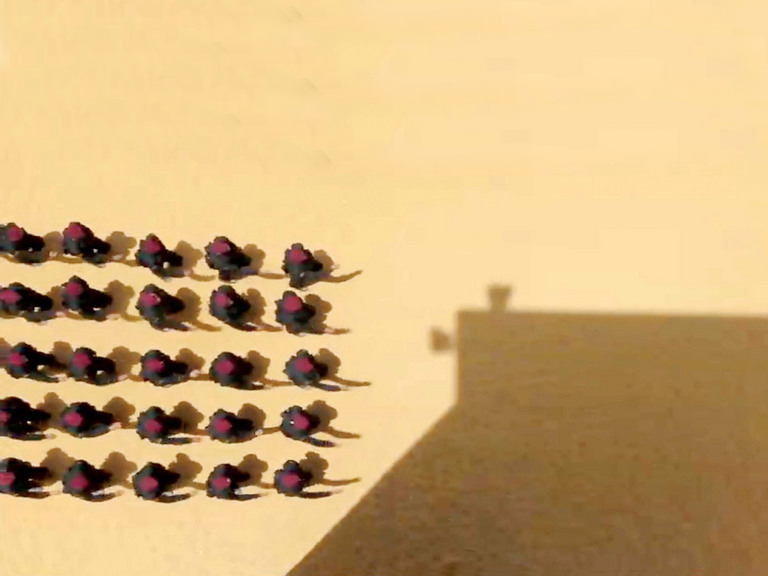The IDF's "selfie militarism" means smiling while playing the bad guy
Yuval, an infantry reservist with the IDF Armored Brigade, testifies to the boredom he and his team experienced seizing houses in Deir al-Balah during Operation Protective Edge in 2014. In a video testimony from the Breaking the Silence archive his face, like all the faces of active duty soldiers testifying to their actions in Gaza last summer, is pixelated. Yuval says “Another team member looked at photos of the family in a family album he found. He wanted to see the family members, so he looked at their pictures, their wedding photos…We’re good boys, we didn’t do anything purposely, but out of boredom we’d look for stuff to do.”
The archives of Israeli occupation are full of evidence like this, of good boys looking for stuff to do. Yuval’s confession offers one fragment of a visual regime—the ability by Israeli soldiers to look at Palestinians with impunity. The bored soldier flipping through a wedding album is part of a ubiquitous surveillance structure that uses drone technology but also soldiers with smartphones and Instagram accounts.
 Adi Kuntsman and Rebecca L. Stein Digital Militarism: Israel’s Occupation in the Social Media Age Stanford University Press (192 pages)
Adi Kuntsman and Rebecca L. Stein Digital Militarism: Israel’s Occupation in the Social Media Age Stanford University Press (192 pages)Kuntsman and Stein take on the ways in which social media facilitates banal participation in the visual regime of Israeli occupation. On social media, broad swaths of former and future IDF soldiers mobilize to support hasbara, the Israeli propaganda project, and increasingly, to publicly applaud what has previously been dismissed as aberrational violence. In 2012, a Facebook photograph of former IDF soldier Eden Abergil smiling next to blindfolded Palestinian prisoners at a checkpoint went viral. In 2012, outrage was directed at the extent to which the image was made public, either at Abergil for posting it or at others for disseminating it. After all, Abergil, like the boys in Gaza, like the thousands of soldiers whose photographs didn’t end up on Facebook, was probably bored and looking for stuff to do.
The album of “Testifiers’ Media” from Protective Edge—unlike earlier Breaking the Silence albums, perhaps reflecting shifting savvy on the part of IDF control over troop smartphone and social media documentation—are devoid of Palestinians. They feature soldiers taking group portraits in the ruins of Palestinian houses, reading in Palestinian chairs, laying on Palestinian beds. All of their faces are blurred. There is no spectacular violence in these images, death happens outside of the frame, on other cameras. In the face of this boredom, the statistics seem both daunting and meaningless; 2,100 Palestinians killed and over 11,000 wounded in just one round of an entrenched violence, an already shaky infrastructure destroyed just in time for a hard winter, the sense that Israel will raze Gaza to the ground before it can be liberated.
Death on camera happens, for example, in the Pulitzer nominated photographs by Tyler Hicks, Sergey Ponomarev, and Wissam Nassar of the New York Times. The images are lauded in their Pulitzer nomination for “capturing key moments in the human struggle in Gaza and providing a fresh take on a long, bloody conflict.” The photographs are riveting, horrific. They show rubble, families in mourning, fleeing refugees, dead children on beaches. The composition is masterful, the colors are rich, the use of light and shadow is beautiful and evokes classical paintings (Ponomarev is especially “noted for his painterly compositions”). Looking at the edit presented for the Pulitzer prize, I try to find the “fresh take” pictured within them. What is novel about these images?
Both the Breaking the Silence project and the Times photographs seem to operate on the assumption that evidence constitutes action, that raising awareness forces change. Gazans in particular are faced with the dilemma of “awareness,” of the hope that if only the world knew, if they saw, they would do something. The Gazan must always act as the witness, must always, in the logic of human rights, play victim against the occupier’s alternative labels: terrorist, suspect, enemy combatant.
In the Times photographs, the IDF is disappeared. In the Breaking The Silence album, the Palestinian is conversely always missing. If Gaza is a land without a people, we are presented with a Goldilocks fiction of occupation, where Goldilocks is the victim because the bear’s beds are too hard and too soft, and they don’t want her in their home at all. Taken together, these albums indicate a double bind for Palestinian representation, the no-choice between exposure and erasure.
In a historical moment where Israeli racism has never been more visible or more claimed, Kuntsman and Stein offer an important intervention. Politicians and citizens, abandoning earlier claims that the IDF is an uncommonly moral army, are calling for greater violence, harsher measures. Digital Militarism turns the scrutinizing gaze toward the Israeli, building a viral archive of quotidian participation in state violence. Kuntsman and Stein identify the unprecedented relationship of the Israeli populace to social networking, and the ways in which, over the past few years, commonplace practices on social media, such are sharing, liking, and taking selfies, has become a mode of reinforcing state violence.
Kuntsman and Stein’s reading of what they call “selfie militarism” is a useful insertion in the perplexing scene of soldier narcissism. Gil Z. Hochberg, in Visual Occupations: Violence and Visibility in a Conflict Zone, released around the same time as Digital Militarism, describes a soldier at a checkpoint, confronted by images taken by a Palestinian photographer, Khaled Jarrar. Rather than recognizing the suffering in the images, the soldier searched for pictures of himself. “Khaled noted that at least one soldier expressed his disappointment when failing to find his image, saying, ‘How could you miss me, I am here every day!’”
Soldiers increasingly create and propagate images of themselves, such as Abergil’s selfie, or Israeli sniper Mor Ostrovski’s numerous Instagram selfies taken on patrol, culminating in the image of a Palestinian child in his rifle’s crosshairs. In these viral selfies, the perpetrator is the photographer and the subject—the perpetrator enacts himself as perpetrator. In 2012, the photograph could still remain evidence of something exceptional because there was only one (viral) image (at a time). Increasingly, social media is flooded with these perpetrator selfies—they follow as well as reinforce the rise of Israeli far-right extremism.
Against readings of social media as an ideologically pure tool of liberation or dissent, Kuntsman and Stein ask what happens when new technologies are put into the service of the state or are shaped by these demands, both in terms of surveillance and populist patriotism. For example, in 2014 an online campaign took off in support of a soldier, David Adamov, suspended for antagonistic confrontations with Palestinians. The campaign included supporters taking selfies with hashtags and signs that either identified the individual in the selfie as standing with or being (i.e. “I too, am David the Nahalite”) the suspended soldier. “Rather than distancing themselves from the online scene of military violence, [Israelis] were marking their solidarity with the perpetrator, joining the selfie meme en mass.” If the key to revolutionary change is witnessing, then what happens when the perpetrators see themselves as such, but don’t care?
The evidence is on video, it is too easy to find examples. In May 2014, Israeli soldier Ben Deri shot and killed unarmed Palestinian teenager Nadim Nawarah in Ramallah—the event was caught on camera, Deri is awaiting trial for manslaughter. In December he told journalists that he was disappointed that he was being treated as a criminal for defending his country. In April, IDF soldiers entered a Palestinian family’s home in Hebron without permission or explanation and climbed to the roof to take a group photo. The event was filmed by the Israeli human rights group B’Tselem. If these soldiers believe, as Israeli deputy foreign minister Tzipi Hotovely does, that the West Bank and East Jerusalem belong to Israel by Biblical right, then what remorse would they feel for such a minor incursion? After all, as the soldiers tell the homeowner, taking photographs of the family the whole time, “Everything’s all right.” Like Yuval’s IDF brigade in Gaza, one can imagine the logic of boredom; “We’re good boys, we didn’t do anything purposely, but out of boredom we’d look for stuff to do.”
Watching this B’Tselem footage on YouTube, across the world, it is easy to feel outrage not only at the incursion, but at the knowledge that I could show this video to any number of Israelis or Zionists who would see nothing wrong with this picture. Both Visual Occupation and Digital Militarism are ultimately about the gaze, about the ability of Israelis to see themselves as perpetrators and about the ability of Palestinians to return, refuse, or otherwise manage the disciplining gaze of military and international aid organizations alike. Kuntsman and Stein, and Hochberg all demand that their readers see a long violence in pictures of events that might be taken as spectacular or ruptural, in images that seem to show nothing at all. The demand to see differently, in this historical moment, emerges as a polarizing force, as Hochberg states frustratingly, “The final outcome…remains in the eyes of the spectators.”
Anti-occupation activists from Palestine, Israel, and the international community urgently capture human rights abuses on camera, daily acting as witnesses, calling for action based on ethical seeing. At the same time, the dominant visual regime of occupation goes ever more viral, rooting itself deeper into the visual order with every like and share. Under the logic of selfie militarism, the soldier who shoots and cries becomes the soldier who shoots and posts. The perpetrator is caught in the act, turns to the camera, and smiles.
